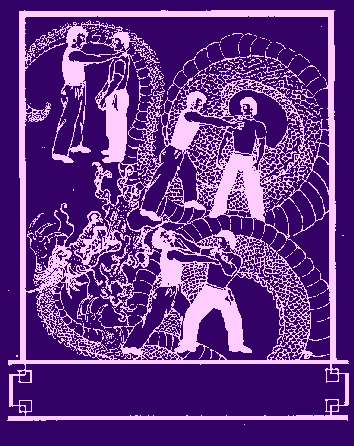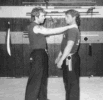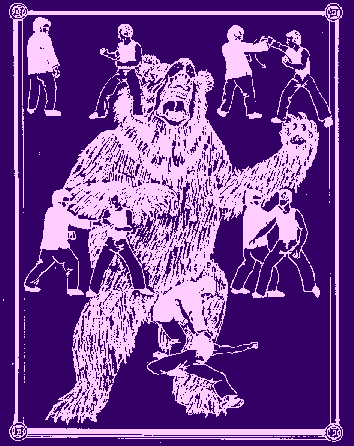
|
The Animal Styles
Sure, we still have concepts like "cat stance," "dragon fist," or "crane position." We were taught they came from the actual movement of animals. But, when asked to explain the connection, or to demonstrate how the stance or the technique could be rooted in nature, we are at a loss. It's a pity, because the movement of animals is a universal language. Thinking of techniques as animal movements not only makes them more teachable, but also easier to remember and integrate into our personal styles. Humor me if you will, and let's see what happens when we focus on a few animals, applying the principles of their movement to self defense responses. The Dragon:
Sequence #1 (The
Dragon) --- The strength of the d The Tiger:
Sequence #2 (The Tiger) --- Here, the defender uses tiger-style techniques to ward off an assailant. The defender first controls the attacker's punching arm, spinning the opponent counterclockwise so his back is now to the defender. Seizing the abdominal pressure points, the defender pulls the attacker backward and down, where he is at the "tiger's" mercy.
The Grasshopper: Why grasshopper? What can
this lowly insect teach us about fighting strategy that
we don't already know? What in the movement of a
grasshopper could be important to us as martial artists? Have you ever tried to capture one? Do you remember how, just as you are about to put your cupped hands over its unsuspecting body, the grasshopper springs suddenly into space, landing off to your side. When you move on him again, just as unpredictably, he springs off to another location. The grasshopper represents constant vigilance, and spontaneous reaction. He is a master of surprise, and has an impeccable command of timing. He is poised under stress, and possesses the innate ability to suddenly move to where you least expect him to. As the attack unfolds, he disappears, suddenly to surface off to the side, or behind...that is the grasshopper. Sequence #3 (The
Grasshopper) --- The grasshopper...now you see him,
now you don't.
The bear represents power, fearless determination, supernatural strength, and ability to resist pain. The fight of the bear is to take pain, to give pain. The bear knows only one direction, and that is forward. It fights to the death. However, like other animals, the bear, too can deceive and surprise. For example, despite its power and its great strength, the bear can transform its appearance to look harmless. If you've ever been to Yosemite Park, picture the bears walking around on all fours, scrounging for food, appearing no more threatening than pets. The same animal, standing on its hind quarters and moving forward to attack, would make even the most sizable human feel like a flyweight. Photo Sequence #4:
(The Bear) --- The "bear" in Conclusion: Our little exercise quickly leads to some tangible benefits. In describing the "animal styles," I am not referring to specific forms that have been choreographed over centuries. Each of the preceding animal "concepts" characterizes a fighting identity, a distinctive fingerprint of physical movement, attitude, and skill distilled into a fundamental essence. This fundamental essence is what we describe when using the name of an animal. It is not unlike the way an astrologer would think of a "libra personality" versus a "capricorn personality." Except that in the realm of physical movement, the practitioner learns to flow from one animal style to another, at will, as the situation demands. Rather than debate the thesis this is how some martial arts originated, why not simply weigh the merit of this approach in your own studies and teaching. In the world today, we are surrounded by constellations of styles and fighting philosophies. We know that somewhere within them all lies a sturdy trunk from which all branches originate. We are now so far removed from the trunk, that it has slmost passed from our ability to recognize it. What better way to retrace the steps of the ancient masters than to clear one's mind of the modern distractions and rediscover the lessons of our surrounding environment? Like the masters before us, we can use those lessons as building blocks in creating our own personal understanding of the martial arts. Anyone wanna hear about the praying mantis...? Author's Comment: If your are interested in undertaking a personal exploration into this approach, I present several additional examples of the types of lessons which might reveal themselves to you, if you are diligent in your quest: The Cobra: Ever hear the expression "snake charmer?" Can you still recollect having seen childrens' cartoons where the semi-naked man with the turban is blowing his flute in front of a cobra, mesmerizing it into passivity? If you came across a cobra in the wild, the roles might be somewhat reversed. The cobra reaches out to your mind, numbs your attention, and holds you motionless and unresponsive while it prepares its attack. Complimenting its innate ability to mesmerize, the cobra comes equipped with lightning reflexes, and characteristically, can strike out at any target, at any time. When I was learning the martial arts, the most admired full contact fighter was Bill "Superfoot" Wallace. Reportedly, Wallace had injured his right leg earlier in his career, and to compensate, had spent years perfecting the body mechanics of his left leg. Consequently, when squaring off against opponents, everyone knew when he kicked, the attack would almost certainly come from the left leg. So, picture the opponent standing across from Wallace in the ring, knowing Wallace is a kicker, knowing he has to kick with the left leg, and knowing as Wallace begins to close the gap, he is setting up the kick. Knowing everything there is to know, how is it still possible for Wallace to pick up his foot, and drive a side kick into the opponent's mid section? The answer to that question lies in the mind of the cobra! The cobra also signifies "reckless abandon." As the cobra rises in front of an opponent, he is disadvantaged in size and maneuverability. His attitude is to be still. If he fails, his soft body is easily broken by even the slightest adversary. Hence, "reckless abandon." The cobra attacks with certainty...there is no margin for error. The Monkey: In the Chinese Opera, it is the Monkey King, whose impeccable Kung Fu skills vanquish all enemies to save the day. In the mind of the public, the monkey, more than all the other animals, typifies the spirit of the martial arts. What they see in the antics of the monkey is innate natural ability, impeccable timing, flow of movement, and boisterous playful confidence. To the martial arts master, these attributes are aspects of inborn talent, or natural ability, and may or may not exist in conjunction with acquired skill. To the initiate, the monkey means skill. The monkey is master of the surface environment. It is his birthright, and that is all. Years of study would add little to that mastery. Because of that, those who fight in the "monkey style" seldom seek mastery of the other styles. It must be stressed their ability is innate. It is very much as though they will see someone execute a move, and if it is appropriate to their natural talents, it will instantly become their move. In the same way, the baby monkey, when first brought to the trees, is soon completely at home in the new environment. Be advised, that when describing the "monkey style," I am not referring to the specific forms that are choreographed over years of training in the Chinese Opera, or in certain styles of Kung Fu, which are named "monkey" styles. I use the word monkey as I use all of the animal descriptives. That is to say, each portrays a certain essence, a specific fingerprint of physical movement, psychology, and skill, distilled to a fundamental essence. In Gun Fu (Animal Fighting Styles), the practitioner learns to flow from one animal style to another, at will, as the situation demands. The Donkey: As you might have suspected, the donkey signifies "resistance." When the donkey refuses to move, nothing its owner can do will make it move. That is the "mind of the donkey." When you are in an arm lock, head lock, wrist lock...if you decide to take yourself out of the hold...you have the discipline to do it, even if it means pain. When you are being choked, or held tightly in a neck lock, you will have the discipline to step out of it, even with the pain. When your opponent is pulling your hair, hitting your pressure points, or tweaking your nose, you will stand firm without surrender, even though there may be pain. When you are goaded into a fight, insulted, spat upon, or egged into a confrontation, you will be able to resist. That is the "mind of the donkey." Developing "donkey mind" does not come easy. We are conditioned to react to pain. Most modern schools of martial arts train people by having them "be victims" for their first several years in the art. This "victim" role becomes part of their conditioning, and subliminally, they learn to go down when somebody pulls their hair, or to remain subdued when somebody puts them into an arm bar. With "donkey mind" all of those techniques would be instantly neutralized. The Ant: The ant symbolizes diligence, determination, impeccable spirit, and readiness to face the unknown. Picture yourself sitting by the pool, when a ten ton dump truck pulls up behind you and drops a load of sand directly on top of your head. After your panic has run its course, you will probably have seen your entire life flash before your eyes, right up to the Pearly Gates. In that situation, your degree in physics would mean nothing. Your ability to bench press 500 pounds would mean nothing. And neither would your four minute mile, or your 9 second 100 yard dash. All of your energy would be focused into meaningless panic. The ant would survive. He knows exactly what he can do, believes in himself, has the courage to execute, and the discipline to persevere. Develop the "mind of the ant" and you too can accomplish the impossible. |
[Home] [About Us
] [Archie] [Concepts] [Contact Us]
[Gun
Fu Manual] [Kata]
[Philosophy] [Sticks] [Stories] [Web
Store] [Terms of Use]
[Video]
Copyright 2000-2024, Mc Cabe and Associates, Tacoma, WA. All rights reserved. No part of this site can be used, published, copied or sold for any purpose, except as per Terms of Use .
 Have you ever heard how
martial arts originated when early masters studied
movements of animals and adapted those movements to
their own responses in fighting situations? Ever wonder
if it was true? And if true, and if the original masters
were really inspired by movements of animals, why is it
today, we no longer look to the animals for insight into
our own technique?
Have you ever heard how
martial arts originated when early masters studied
movements of animals and adapted those movements to
their own responses in fighting situations? Ever wonder
if it was true? And if true, and if the original masters
were really inspired by movements of animals, why is it
today, we no longer look to the animals for insight into
our own technique? The dragon is traditionally
represented as a huge fire breathing lizard, possessed
of a large body, supported by strong formidable legs,
and an elongated tail. Almost always, the arms are
disproportionately small, or non existent. If we were to
look at the dragon as a potential opponent, our initial
focus would have to be the diminutive hands. The power
of the dragon is not in the hands, but rather, in the
body, legs and tail. Because its hands are virtually
useless for anything but blocking and clenching, the
fight of the dragon is one of position. Using its feet,
and its low center of gravity, the dragon instantly
positions itself where its strength is maximized and its
vulnerability minimized. The dragon means position,
stance, opening your opponent to counter, and closing
yourself to attack. When executed properly, you have all
the openings; your opponent has none.
The dragon is traditionally
represented as a huge fire breathing lizard, possessed
of a large body, supported by strong formidable legs,
and an elongated tail. Almost always, the arms are
disproportionately small, or non existent. If we were to
look at the dragon as a potential opponent, our initial
focus would have to be the diminutive hands. The power
of the dragon is not in the hands, but rather, in the
body, legs and tail. Because its hands are virtually
useless for anything but blocking and clenching, the
fight of the dragon is one of position. Using its feet,
and its low center of gravity, the dragon instantly
positions itself where its strength is maximized and its
vulnerability minimized. The dragon means position,
stance, opening your opponent to counter, and closing
yourself to attack. When executed properly, you have all
the openings; your opponent has none. ragon lies in physical position. Here,
the defender escapes from a frontal choke by merely
turning and stepping back. If he chooses to counter,
he can trap the asailant's right hand and claw the
eyes.
ragon lies in physical position. Here,
the defender escapes from a frontal choke by merely
turning and stepping back. If he chooses to counter,
he can trap the asailant's right hand and claw the
eyes. The tiger is most
distinguishable by its ability to use its paws, or hands
to attack and control an opponent. The trademark of a
tiger is its ability to move with power, grace and
balance. When the tiger moves, it is always with
characteristic feline poise. When it attacks, it moves
inside or around the opponent's stance, never allowing
an opponent the chance to recover. The tiger
instinctively attacks the vital areas. Combined with the
dragon, its movement is finished only when the opponent
is annihilated.
The tiger is most
distinguishable by its ability to use its paws, or hands
to attack and control an opponent. The trademark of a
tiger is its ability to move with power, grace and
balance. When the tiger moves, it is always with
characteristic feline poise. When it attacks, it moves
inside or around the opponent's stance, never allowing
an opponent the chance to recover. The tiger
instinctively attacks the vital areas. Combined with the
dragon, its movement is finished only when the opponent
is annihilated.

 Blocking an attacker's punch, the
grasshopper stylist "springs" to the assailant's side,
hooking his right foot with the defender's own left
(see close-up). The defender then pulls the attacker's
foot to the rear, dropping him to the ground.
Blocking an attacker's punch, the
grasshopper stylist "springs" to the assailant's side,
hooking his right foot with the defender's own left
(see close-up). The defender then pulls the attacker's
foot to the rear, dropping him to the ground. The Bear:
The Bear: waiting (in this case the defender)
appears harmless and defensive. He neutralizes a
punching atack, then moves forward, establishes
position and, reassuming its true nature, strikes the
opponent's head, slamming him to the ground.
waiting (in this case the defender)
appears harmless and defensive. He neutralizes a
punching atack, then moves forward, establishes
position and, reassuming its true nature, strikes the
opponent's head, slamming him to the ground.